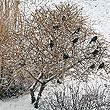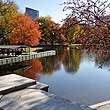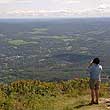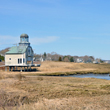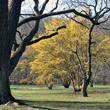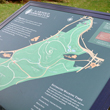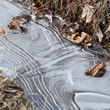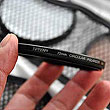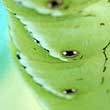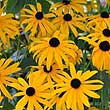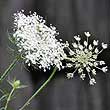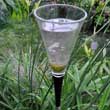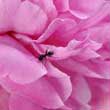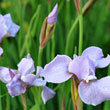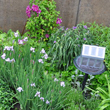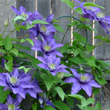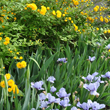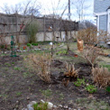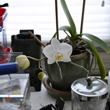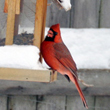|
|
 |
| RainyDayGarden's content can now be licensed for your print magazine or web site. Please contact us directly here. If you want to see something reviewed, then drop us a note with a link and we'll be happy to take a look. |
| |
| Sep 27,2010 - Fiskars: Fall Cleanup Gear... |
The cooler and drier Fall weather is not only great for outdoor projects, it is also a signal for the leaves on the trees to change color. This annual "event" is so spectacular that folks from all over come to New England to see the change. While everybody loves a party, when it is over, it is the host who has to clean up. The Fall clean up is a chore which can be made a lot more pleasant with the right tools.

We have always known that Fiskars makes great scissors. A few years ago, we discovered they also have an excellent line of pruners and loppers for gardeners. When we went looking for tools to help with our Fall cleanup, we were happy to find that Fiskars has some great gear designed to make the task easier. Tree pruners, rakes, and cleanup bags, they have 'em all and more. These Fiskars gear are not just "me-too" products. They have been rethought, reworked, and... [more]-Fiskars: Fall Cleanup Gear
|
|
| July 15,2010 - RDG update ... |
The weather in Boston at the end of June and the beginning of July was brutally hot. There wasn't any rain for two weeks and things were starting to droop. We resisted watering the vegetable garden for as long as we could, but finally gave in on the long July 4th holiday weekend.

Most of the plants in the GrowBed are doing great. The herbs have established themselves nicely. The basils seem to have something going on with the leaves. We are not sure what it is, but it does not appear to be... [more]- RDG July update
|
|
| June 09,2010- Container Garden Update ... |
We had a couple of really hot days in May, which we thought might be too much for our new plantlings out in the garden, but the amount of May rain kept the plants happy and thriving (with just a few additional waterings from the hose). Currently, all the early tulips have bloomed, as have the Japonica, Forcythia, and most of the irises. The day lilies and lamb's ears have started sending up their flowering stalks. They should start to flower in another week or so. The peonies popped a week ago, but were battered around a bit by a thunderstorm. We harvested as many as we could and brought them inside to enjoy.

The new raised-bed vegetable garden really took off last month. The tomatillos and tomatoes flowered in mid-May and have started to fruit. The early peas were true to their name. The pods formed and we have already had our first harvest (ie, standing in the garden and eating them right out of the pod). The zucchinis have flowered but the fruit has yet to form. We have learned that zucchinis, while often thought of as a vegetable, is actually an immature fruit.

We acquired some winter melon seedlings when we were last in NY. They have been planted and are getting acclimated to their new home. Hopefully, they will establish themselves and provide us with... [more] -Container Garden Update
|
|
| June 08,2010- Vanderbilt Museum ... |
We were down in NYC last weekend for the World Science Festival. The 90º temperature in the city had us looking for cooler diversions on Saturday. After a bit of searching, we came up with the Vanderbilt Museum in Centerport, Long Island. It was less than an hour's drive from NYC, and 43 acres of rolling hills was a nice escape from the "concrete jungle."

This museum was built by Willian K. Vanderbilt II on his Eagle's Nest Estate. The 24-room Spanish-Revival mansion was built in three stages off and on from 1900s to 1930s. We did not have time to take the house tour or see all of the grounds on this visit, but managed to hit many of the museums and some of the gardens.

As a person of means, William Vanderbilt II (he was the great-grandson of Cornelius Vanderbilt) fed his curiousity of natural history by mounting specimen-collecting voyages to the Galapagos and other exotic destinations. He opened his personal museum to the public in 1922. The photos here are just a small sample of the artifacts from his extensive travels and expeditions. On display were an impressive and varied array of... [more] -Vanderbilt Museum
|
| May 17,2010- RainyDayGarden Update ... |
The weather in Boston was all over the place at the beginning of May, but it has finally settled down. Everything we planted in mid-April survived the frost-warnings and 30º temperature gyrations in day/night temperatures. We also got some nice stretches of rain. The precipitation really helped get everything nice and green.

The tulips and the other early bloomers have mostly faded. Their blooms were replaced by the clematis, azaleas, and alliums. Many of the plants have started to fill out, but some of them are not quite ready to flower. It will be another week or two before the... [more] -RainyDayGarden Update
|
|
| April 23,2010- Planting tomatoes in April... |
| One of the advantages of a raised-bed garden is that the above-ground soil has an opportunity to heat up during the day. The warmer soil allows vegetables to be planted earlier than would be possible otherwise. We sprouted beans in March and planted them on April 8th. They have been in the ground a few weeks now, have clearly established themselves, and have begun sending out climbers. This encouraged us to think about getting some tomatoes and other plants into the GrowBed.

April 13th was another above-65º day. We didn't have much on our schedule and thought it would be a good time to make a Home Depot run. Fortunately for us, it was also the day of their first delivery of vegetable plants from their supplier. We had "first pick" of plants as they were being unloaded from the truck onto the shelf. Home Depot's supplier is Bonnie Plants of Union Springs Al. All of the seedlings looked vigorous and were... [more] -Planting tomatoes in April
|
|
| April 13,2010- RainyDayGarden's MarchMadness... |
March was a very odd month this year. It started out dry, but got very wet very fast. Record-breaking rains (twice in two weeks) turned the Northeast into a giant puddle the old timers said they haven’t seen for more than a 50 years. Staggering amounts of rain fell in Connecticut, Massachusetts, and New Hampshire. Rhode Island suffered the most with some areas recording 10 inches in just a few days.
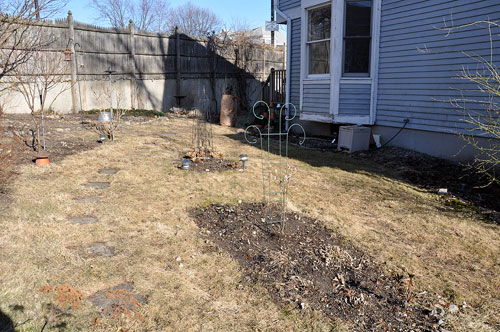
On March 6, the weather folks announced that rain was on its way. Newer technology had made their predictions a lot more accurate, so the interns heeded the warning and got things cleaned up before the storm. It was a good thing they did because the rain did come, and... [more] -RDG's MarchMadness
|
|
| April 9,2010- Boston Nature Center:SpringFling... |
We have been frequent visitors to the Boston Nature Center (BNC) for years. It is an urban sanctuary, located on the grounds of the former Boston State Hospital. We often use it as a testing ground for outdoor gear we review. The BNC offers public programs year-round. Through its Boston Schools Initiative, the BNC provides environmental education programs to local elementary schools weekly.
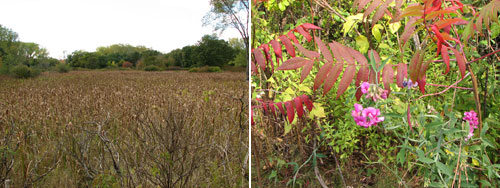
Over two miles of handicap-accessible trails and boardwalks traverse the meadows and wetlands. Wildlife such as coyotes, pheasants, and many species of migratory birds can often be seen. The sanctuary’s George Robert White Environmental Conservation Center is one of the “greenest” buildings in Boston, teaching environmentally sustainable design by example.
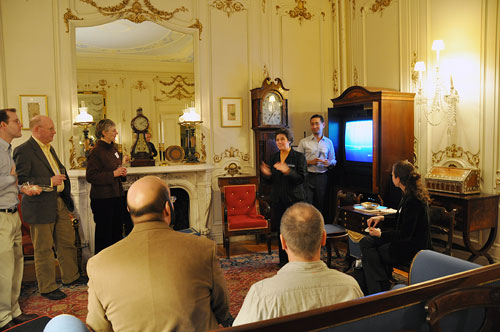
A few weeks ago, we attend a BNC event at our friends Bill and Irfan's home. We had the opportunity to meet Julie Brandlen, Director or the BNC, and many of the other friends of the BNC. The event was to introduce some of the folks in the Back Bay and Boston to this fantastic urban resource. We heard from folks who helped envisioned, designed, and built the center. We also had a chance to chat with many folks active in the Massachusetts Audubon Society as well as... [more] -BNC SpringFling
|
|
| April 8,2010- Garden prep... |
The release of the iPad on Saturday sucked everyone into a digital black hole. After a few marathon review sessions of all things iPad, we defied known physical laws, climbed our way back up to the event horizon, and managed to extricate ourselves from the gravitational field-distorting pull of our shiny new iPad. The unseasonably warm 90º weather helped. To make sure that the "real" world was indeed still analog and to help us regain our bearings, we
decided to do some gardening.
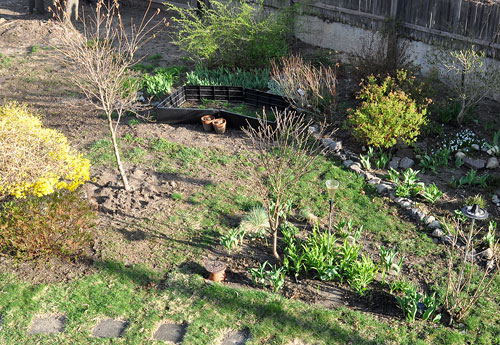
When we last left the RainyDayGarden, we had assembled the GrowBed from our friends at the Gardener's Supply Company. We were trying out various shapes for the bed and decided a chevron configuration was the best fit for our existing garden layout.
The next step was to fill the GrowBed with garden soil. The size of the GrowBed is 3'x6'x10", so 18 cubic feet (CF) should be sufficient. To help us keep our cost down, we decided to get 12 CF of top soil ($1.50/CF) and 6 CF of gardening soil from MiracleGro ($4/CF).

The MiracleGro's claim is that stuff grows twice as big if planted in it. We didn't set up a double-blind test bed (next season) so we won't be able to say. However, it is more than twice as expensive as regular top soil, so let's hope they are at least a little better:-) Also, instead of... [more] -Garden prep
|
|
| March 25,2010 |
Starting plants from seeds is a satisfying part of setting up a garden.
There are many ways to do it. The basic requirements are some soil, a container, a warm bright spot, and the seeds. The only care needed is to keep the seeds moist until they germinate.

Egg cartons made from fiber are readily available and biodegradable and free (once you have purchased the eggs), which makes them the container of choice for many seed-starting projects. However, fiber egg cartons will both absorb water and leak all over if not placed on a tray.
Fortunately, some egg sellers have upgraded to newer technology and now ship their eggs in clear plastic cartons.


These are perfect for
starting seedlings, as the clear cover serves as a mini-greenhouse to keep the soil moist and warm. An obvious benefit of a plastic container is they don't need a drain tray. Stacking and moving them around is much easier. Labeling of what was planted can be done directly on the cover. Some have a built-in gap to allow for air circulation, others have two covers which can be used to prop itself open to encourage air flow.
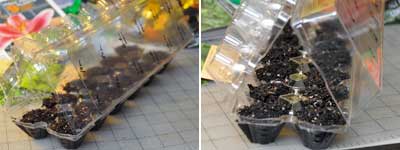

The seeds have been planted. The containers will sit at a south-facing window, checked daily, until they germinate. We'll have photos of the growth and progress of this effort over the next few week.
[Permalink] -Seeds and Starters
|
|
| March 24,2010 |
We are thrilled with the signing of the landmark healthcare reform bill
yesterday. The fight was brutal and those opposed to the new law are still actively seeking to hinder it in any way possible. We would like to ask...did any of the following pass without opposition?
- Emancipation Proclamation by Lincoln
- Women's suffrage by Wilson
- Lend/Lease by FDR
- Desegregation of the military by Truman
- Civil Rights Act by Johnson
Who would stand against these today?
Regardless of how people feel about the new law, staying healthy is probably one of the items on most people's top-ten list. There are many ways to approach that goal: eat properly, exercise appropriately, and have regular medical checkups. When we do get sick, today's pharmaceuticals have a cure for many of the the things that in previous genenerations would have caused our demise. There are also things we can do for ourselves when we have some of the more common conditions like acne, anxiety, cold sores, and general aches and pains.

Herbs and plants have been used for thousands of years to treat common ailments. The common view is that plant-based remedies are natural, inexpensive, and less harmful to the body than manufactured drugs.
Plants have provided Western medicine with some of its most effective drugs: penicillin, morphine, aspirin. Of course, there are plenty of plant-based "treatments" that are poisonous, do not do much of anything, or are just plain useless. The same can be said of some pharmaceuticals.
The key is knowledge of what is effective and why.

James Wong, a 27-year-old ethnobotanist, believes that safe, natural remedies can be made from the everyday plants we can grow in our own garden. Grow Your Own Drugs: Easy recipes for natural remedies and beauty fixes, is a book which shows how we can grow, make preparations, and use plants to soothe the symtoms of everyday ailments the natural way.

The second book, A Year With James Wong, has 100 new remedies, a seasonal guide and planner, and foraging tips. The planner takes the reader through from Spring to Winter, advising on what and when to plant, the best time to harvest, and how to create a mini-apothecary at home.


Both books (GYOD, GYOD+) help interested readers navigate the old wives' tales, look beyond the aesthetics, and to see plants as sources of medicine. The books are informative, beautifully photographed, and are wonderful additions to any library. We will try many of the recipes, adding some of the plants to our garden, and report back on how they perform as part of our Backyard Biotech series. [Permalink] -Grow Your Own Drugs
|
|
| March 22,2010 |
The temperature was in the high 60s most of the weekend. We took advantage of the unseasonably warm weather to prep the ground and assembled the GrowBed that we got last week from The Gardener's Supply Company.

The 3'x6' GrowBed came in two separate boxes. The larger box had the 3'x3' unit. The smaller box had the extension to make the 3'x6' bed. The panels for the GrowBed are made from recycled plastic materials, are quite rigid, and should last for many seasons.

The 3'x3' kit contained four 3' panels, connecting spikes, and corner covers. The extension kit consisted of two additional 3' panels, two support plates, and a U-shaped connecting rod.
All the panels have integrated joints which allow them to be connected by the plastic spikes. The entire assembly process took about 10 minutes from start to finish. No tools were needed for assembly.


We did not install the side bracing because we are not sure that the rectangular shape is the one we want for the Grow Bed. We are going to see if a parallelogram or a rhombus configuration would fit better with the
"visual flow" of the garden. However, we'll leave it as is and decide in the next few days.

Once we have the final orientation and shape, we'll fill it and get it ready for planting. Some of the seedlings (tomatoes, peppers) will come from the local nusery, some we'll start from seed. For the ones we will be starting from seed, we are going to make our own seedling starter greenhouse out of some clear egg cartons. We have never done it before, so it will be an interesting experiment.
[Permalink] -Grow Bed Assembly
|
|
| March 16,2010 |
Working on a vegetable garden is a wonderful and relaxing diversion for many. However, if you are a beginner, getting started can be
somewhat intimidating. How to set one up?
How big should it be?
What and when to plant?
Fortunately, Gardener's Supply Company has made it easy with their planners and "How To's." This year, we want to do a series that follows the process from starting a vegetable garden in the Spring, tending it during the Summer, and all the way through to harvesting in the Fall.
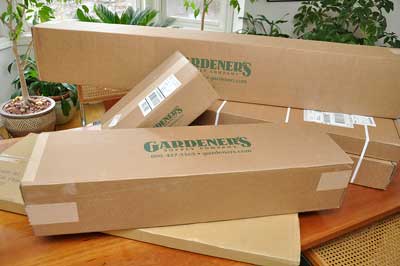
We chose the Gardener's Supply "Plant It and Forget It" garden setup, but we may reconsider and go with their "High Yield"
garden. We still have a few weeks to decide what plants to get.
The supplies we got would work for either one.
We got three tomato cages, three vegetable cages, a bean tower, a 3x6 grow bed, and a 5lb bag of organic fertilizer.
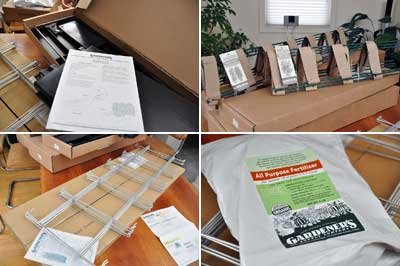
The tomato and vegetable cages are much stiffer than we expected. They are made of 7mm thick steel rods, quite a bit thicker than the ones you can get at typical gardening centers. Also, these cages are weatherproofed using powder coating instead of plastic. This means they will not peel and should last quite a few seasons.
The bean tower is a rectangular design, folds flat, and is over 6' tall.
It is rods are not as thick as the vegetable cages, but are plenty sufficient for supporting bean plants.


There are many advantages to gardening in a raised bed: they absorb heat to warm soil early in the season, they help retain moisture all season long, you can control the quality of the soil, and they require less maintenance in general. The sides of the Gardener's Supply grow beds are made of recycled black plastic. The bed can be assembled quickly and has a generous 10" depth.
The 3' x 6' size is large enough for a good yield without being overwhelming, especially in our urban setting.
Setting up a raised bed garden also means no digging. This was welcome news to the interns.
All in all, we are very impressed with the quality of the items from Gardener's Supply Company. We look forward to getting the garden set up outside and prepped for planting.
[Permalink] -GSC Gear FirstLook
|
|
| March 15,2010 |
If this past weekend was any indication, March is coming in like a lion. It appears the April showers have gotten an early start as well.
We are glad we got things cleaned up a bit before the rain came. According to our gauge, we got well over 2" of rain in less than 24 hours.
All this precipitation is great for the garden.
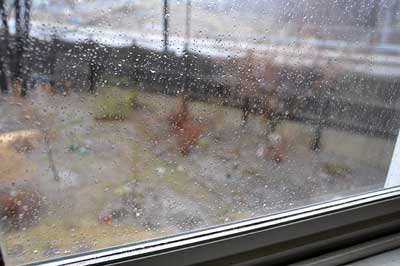
Last Summer we gave our huge Japonica bush a heavy hair cut.
The question for us is, what are we going to do this Spring to fill in the space? We considered planting annuals, but doing the same work every year does not seem to be the best way to go.
It is a bright sunny spot, so the suggestion was to turn the empty spot into a cutting garden using perennials.

We considered heading back to Logee's to see what they could offer. Another possibility was White Flower Farm in Connecticut.
White Flower Farm came highly recommended from readers who sent us comments after reading about Logee's. While we did not end up getting anything from either place, we were impressed enough with White Flower Farm to add them to our list of potential field trips for this year.

Success came from a more local source. On a recent visit to Home Depot, the interns came back with these "Special Buys." Considering we once paid $20 for one day lily plant, $17 is a great price to pay for a whole collection.
The Home Depot collection has a dozen plants for less than what we paid for one. The lily collection has twice as many plants as the day lilies. The best of the three had to be the gladiolus collection. At 120 bulbs per box, it is just an amazing value. We don't have any gladiolus in the RainyDayGarden, so these bulbs will be a great addition.

The lilies came packed in loose peat. Some of the plants have already sprouted shoots. We will need to get them into the ground soon or they will waste all of their energy trying to get out of the bag. In contrast to the lilies, the gladiolus bulbs all appear dormant. Regardless, all of them will be in the ground by early April.

For those interested, starting a city gardens can be tricky.
One never knows about the quality of the soil, the ease of the drainage, or how many rocks are hidden below the top layer. We have had some success growing things in our limited plot outside. However, as many have discovered, planting a garden is oftne easier than taking care of one; so much to do, and kind of all the time.
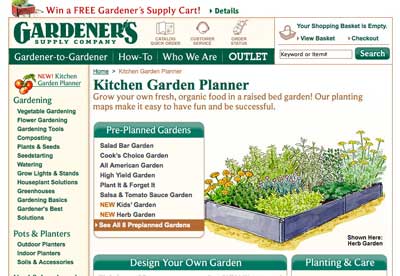
This year we thought it would be instructive to start a city garden from scratch. Gardener's Supply Company is an excellent resource for all the things needed to get one up and running, er, growing. Their site is very helpful for planning, especially if you kind of know what you want to accomplish, but don't know exactly what all you need.

After lookng around we decided the "Plant It and Forget it" garden best fit our gardening style. The supplies arrived last week. As soon as the rain stops, we'll be setting things up. It the meantime, we'll unpack everything this week and take a closer look at the gear.
[Permalink] -Spring Prep
|
|
| March 1,2010 |
One of our monthly readings is a magazine call The Scientist. We read it because it is a way for us to keep up with what's happening in the life sciences without having to wade through the heavy stuff in Science. The cover article of the first issue of 2010 was about whether it was time to update some of the current thinking in Evolutionary Theory.
We found the article in The Scientist absolutely fascinating, as we had not seen a summary of the various extensions to the Julian Huxley's 1942 book Evolution: The Modern Synthesis .
However, that is not the part we wanted to discuss today. .
However, that is not the part we wanted to discuss today.

The item which sparked today's article was a line in Richard Gallagher's list of the problems with the study of the life sciences today. The ten
problems as seen by the departing editor were all on-target, especially item no.9.

The Creationist crackpots have been trying to discredit Evolutionary Theory for quite awhile now.
Stupid ideas have their own energy and momentum. Sometimes it is because those ideas are simple and easy to digest. Other times is because they are comforting. However, it is astounding that a thinking person who has managed to graduate from a certified high school can possibly entertain such clap-trap. Yet, this backwater idea (and the dismissive tone is intentional) continues to take energy away from serious scientific dialogs.

We want serious thinkers and scientists to challenge conventional wisdom (like Galileo disproving Aristotle's theory on falling objects), to upset the apple cart based on observations (such as Copernicus showing that the Sun and not the Earth is the center of the Solar System), and to open new worlds with genius intellect (Einstein resetting everybody's perception of time and space).
Extending Darwin's theory on Evolution does not make his original thinking invalid, it makes the understanding of our world more accurate. There are an enormous amount of things Science does not know and cannot yet answer. What we do know is that at no point would we ever want to repeat the past mistakes of the use of Faith to confine or define the facts of Science. In THAT we have faith. [Permalink] -Darwein 3.0
|
|
| February 18,2010 |
Most house plants die because they are over-watered or forgotten. For our interns, the task is made easier because we made it into a routine: once a week for plants in small pots, once
a month for plants in large pots. However, if you don't have cheap labor available, then you might want to consider the Eva Solo self-watering containers. We posted a FirstLook on these containers a few years ago.
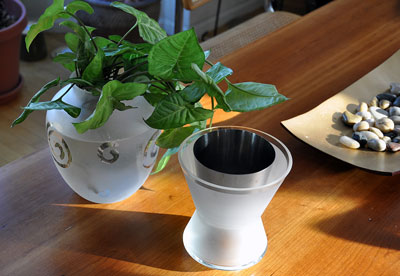
We have
been using the Eva Solo planter mainly as a way to arrange cut flowers or to root cuttings.
This high-quality planter is comprised of three parts: a thick glass container, a stainless steel cone, and a saucer with nylon wicks.
The system is both attractive and functional.
They are perfect for water-loving plants that you don't want to go thirsty.
A great thing about using the Eva Solo container to root cuttings is that the tall conical shape of the stainless steel sleeve makes it easy to arrange the cuttings for display, and adding water to the container will not disturb the arrangement.


Another thing about the Eva Solo planter is that once the cuttings have rooted, they may be planted directly in the container.
The
limitation is that some plants will quickly outgrow the relatively small size. Still, growing the plants in this container will ensure a great start and a healthy root system
for many types of plants.

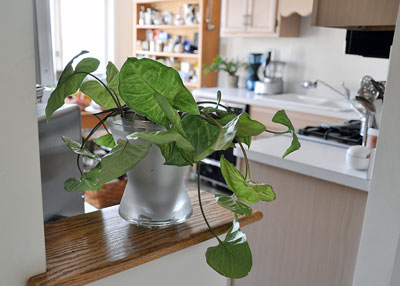
Rooting plants in water is a simple and low effort way to turn one plant into many. You can do it with any normal glass container or with something a little more specialized. Either way, it is a great way to decorate as well as propagate. Best of all, it is free :-) [Permalink] -Eva Solo Planters InTheWild
|
|
| February 17,2010 |
Spring is still a few months away, but that does not mean we can't do some gardening indoors while the ground is frozen solid outdoors.
One of the things we like to do for the RainyDayGarden during the Winter months is propagate plants.

In the Spring and Summer, we propagate plants mostly by using rooting hormones and then plant the cutting directly in the ground. We find the method to be both highly successful and requires relatively little maintenance. In the Winter, we start out the cuttings in water and transplant them into pots when they have developed a sufficiently robust system of roots.
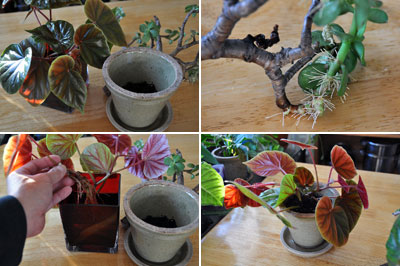
There are other ways of propagating plants. One ways is, instead of taking a cutting, to propagate a plant by air layering. The folks at Turkington's Garden have created a
product call "Turkington's Rooting Stakes" which makes it possible to root plants easily. It uses the same principles as air layering, but done directly in the soil.
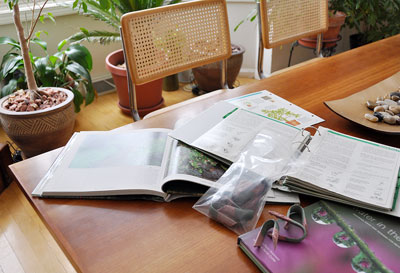
The rooting stakes are made of reed, a natural product. They are treated with a natural rooting hormone and then dipped in an organic starter fertilizer. The idea is that the rooting hormone promotes root growth and the starter fertilizer feeds the roots to get the plants established quickly.

In these economic times, we are always encouraged when we see great ideas sprout. This one from Turkington's is a very clever one. We will give these Turkington Rooting Stakes a try once the ground has thawed. Turkington’s Garden Products is a local startup located in Concord, Massachusetts. We hope their products will take root and spread. We will do what we can to nurture and help them grow. We encourage RainyDayGarden readers to do the same! [Permalink] -Plant propagaton by rooting
|
|
| January 3,2010 |
It has been snowing for three days straight. Most of the stuff coming down is light and fluffy, but it is starting to pile up! All this snow is making it more difficult for some of our friends in the RainyDayGarden to get their daily fill. The feeders are filled everyday and the news of the free food is making its way around the neighborhood. All kinds of creatures are stopping by to check out the menu.
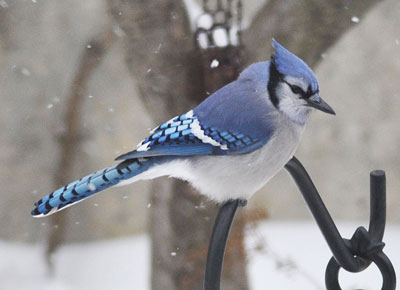
The Jays and the Cardinals are big birds and can usually fend for themselves. The sparrows make up for their small size with sheer number. Five sparrows on a feeder will make a Blue Jay think twice about landing. Of course, nothing will deter the wily squirrel...and we have stopped trying :-)
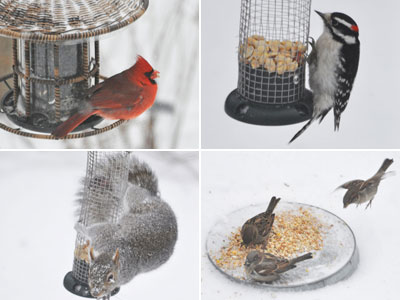
There is some sort of order to all of this feathery feeding chaos. Those not interested in fight for the "first feed" privilege are content to wait in a nearby bush until the more aggressive ones have had their fill. However, even the timid ones are starting to realize that they have to fight for spot on the feeder instead of just waiting for stuff to fall to the ground.
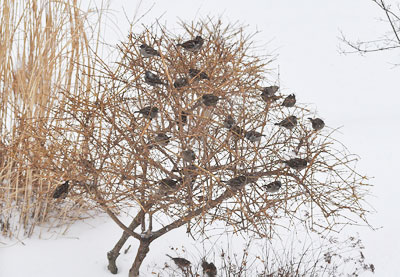
It is nice to see that even though we are in the city, there are still plenty of interesting wildlife out there. All it takes are some seeds and peanuts to bring them within visual range. [Permalink] -Feeding Time
|
|
| January 1,2010 |
Aren't robins suppose to be the harbinger of Spring? Well, we were down on Commonwealth Ave in Boston today and came upon a tree full of those red-breasted feathery friends.
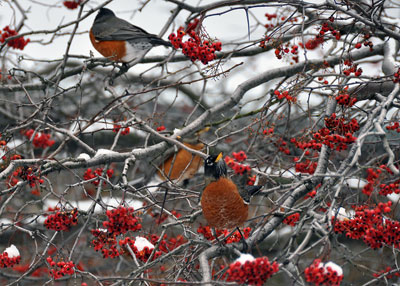
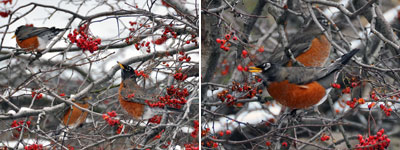

Even though the new year just got started, a lot of good things are already in place. We have an intelligent president, healthcare reform looks like it may finally become a reality, and the market is starting to show small signs of life. There is still a staggering amount of work to be done, but we are taking today's robin sighting as a good sign...
Happy New Year!!!! [Permalink] -New Year's Day
|
|
|
|
|
|

